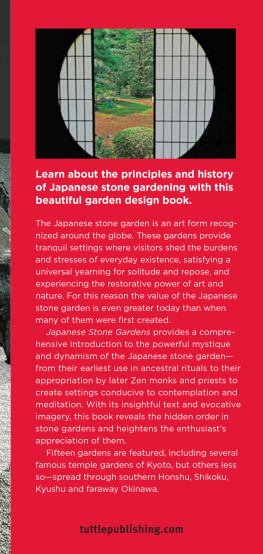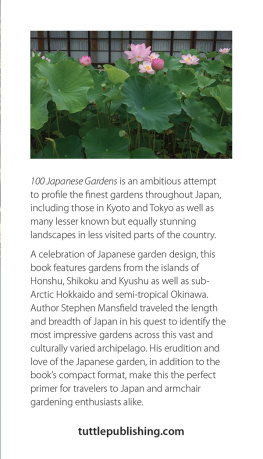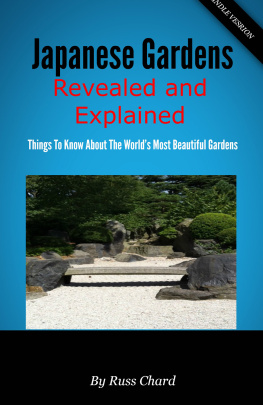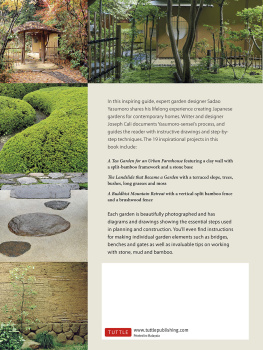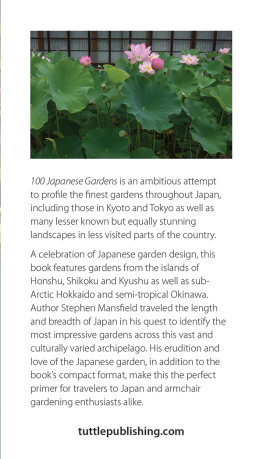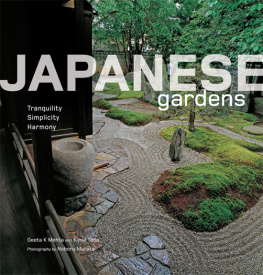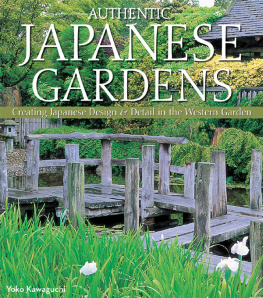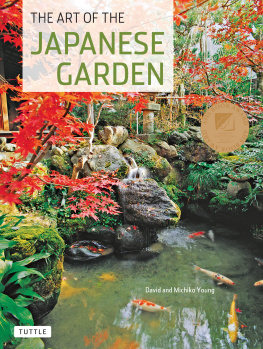PAGE 1 The perfect shakkei or borrowed view at Shoden-ji Temple ().
PAGE 2 Stepping stones at Raikyu-ji () lead to a cluster of rocks commonly interpreted as representing either Mount Sumisen or a crane island.

Published by Tuttle Publishing, an imprint of Periplus Editions (HK) Ltd
www.tuttlepublishing.com
All rights reserved. No part of this publication may be reproduced orutilized in any form or by any means, electronic or mechanical, includingphotocopying, recording, or by any information storage and retrievalsystem, without prior written permission from the publisher.
Photos 2009 Stephen Mansfield
Text 2009 Stephen Mansfield
Library of Congress In Catalog Publication 2011279075
ISBN 978-4-8053-1427-2; ISBN 978-1-4629-0598-0 (ebook)
Previously published ISBN 978-4-8053-1056-4
Distributed by:
North America, Latin America & Europe
Tuttle Publishing
364 Innovation Drive, North Clarendon, VT 05759-9436, USA
Tel: 1 (802) 773-8930; Fax: 1 (802) 773-6993
Japan
Tuttle Publishing
Yaekari Building, 3rd Floor
5-4-12 Osaki Shinagawa-ku, Tokyo 141 0032, Japan
Tel: (81) 3 5437-0171; Fax: (81) 3 5437-0755
Asia Pacific
Berkeley Books Pte Ltd
61 Tai Seng Avenue #02-12, Singapore 534167
Tel: (65) 6280-1330; Fax: (65) 6280-6290
19 18 17 16 10 9 8 7 6 5 4 3 2 1
Printed in Hong Kong 1608EP
TUTTLE PUBLISHING is a registered trademark of Tuttle Publishing,a division of Periplus Editions (HK) Ltd.
Large granite rocks at a pavilion beside Kongobu-ji, Shingon sect temple on Mount Koya, a sacred Buddhist complex in Wakayama Prefecture.
PAGES 67 Two of three rocks in a stone triad, named the Chukai or middle sea, in the garden section of Daisen-in, a sub-temple of Daitoku-ji in northern Kyoto.
CONTENTS
FOREWORD
ABOVE The pipe, mat and teapot in this illustration demonstrate that private gardens were not always used strictly for meditation practices.
When Isaac Watts, the well-known eighteenth-century hymn writer, wanted to suggest an ideal site for meditation, he chose the image of a garden:
We are a garden walled around,
Chosen and made peculiar ground;
A little spot enclosed by grace,
Out of the worlds wide wilderness.
Here, within this natural corner, was a place for us to contemplate, a garden within us, burgeoning but quiet, alert, alive but still. It was, as Francis Bacon had written a century earlier, indeed of divine origins: God Almighty first planted a garden...."
This confluence nature and ourselves, deities and mankind is one which occurs time and again as we experience a constant need for more than what our meager civilizations can afford us. Perhaps that is why we believe that God Almighty created this quiet utopia. It is because we think that we ourselves could construct only a matching dystopia.
God, the first garden made and, the first city, Cain, wrote the seventeenth-century poet Abraham Cowley in his attempt to explain both our needs and our limitations. The imperatives and constraints are very real, and they are basic. Gods gardening goes on all over the world, and we, children of Cain, in the midst of the worlds wide wilderness, go on making messes.
One of the most beautiful expressions of this need and one of the only indications of its solution is found in the Asian attitude toward meditation as seen in the subject of this book: the stone gardens of Japan.
Gardens of stone these we might see as contradictions in terms. Such a description would seem to deny the very qualities we assign the garden something supposed to be organic, growing, changing, burgeoning. When, however, we examine these Japanese corners for contemplation, we see that it is their perceived bareness that renders visible their possibilities. Purling brooks are not necessary for understanding, nor deep pools for profound and personal depths.
Just as the Japanese tea ceremony and the ikebana flower arrangement make frugality a virtue, creating with the simplest of means a world of stillness and beauty, so the rock garden creates an ideal landscape, a garden for the mind.
One might compare these seemingly severe stone gardens of the East to those floral gardens with which we are more familiar in the West. The gardens of Versailles, for example, are based upon a number of familiar assumptions: that man is lord of the universe, that there is a place for everything and everything has its place, that earthly perfection may be expressed in terms of the geometric placement of trees, bushes, flowers. This is an anthropomorphic notion based upon simple certainties.
The gardens of the East are no less anthropomorphic but their assumptions are not those of post-Renaissance Europe. Rather, these gardens were influenced by a more basically religious thought it was esoteric Buddhism that gave the Japanese garden its philosophical model.
Here, the garden was like a mandala, a symbol of the universe as seen in the Hindu religion, or the Buddhist. This the believer viewed and through it understood. In it, the believer recognized a replica. It was a means of meditation that mediated between the individual and nature itself.
In the stone gardens of Japan, the meditative view is simplified, rendered down to its elements, reduced (or enriched) to its essence. In its way it assumes just as much as does Versailles (and it is certainly as consciously designed) but what is assumed is far different.
Of what this consists the reader will learn in the following valuable pages. A Japanese attitude toward nature lies in the constant endeavor to extract the essence of a flower, of a stone. But in order to accomplish this, one must recognize the nature of what is being viewed.
The original view, the natural stone, however, is never natural enough for the Japanese. Rather than working against nature as does, let us say, Versailles, the Japanese gardener works along with this nature that is being revealed. He or she parallels the grain of the material. There is pruning and placing but these result in the revealing of a line that nature originally created. It is this that we contemplate. Indeed, the emergence of this line, this view, is in itself a kind of meditation.

